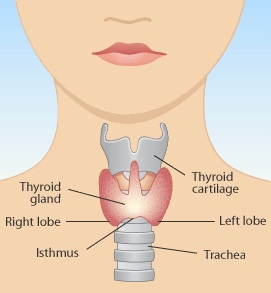Thyroid function is a hotly debated topic in the low-carb world. While most people typically experience fat loss, better energy levels, and improved overall vitality on a low-carb diet, in some individuals, measurements of thyroid-related hormones suggest that a low carbohydrate intake might be having adverse effects on the thyroid gland. Is it possible that a way of eating that has such wonderful benefits for so much of the body could be harmful to the thyroid?
This is the fifth installment of a series exploring lab tests for people following low-carb diets. Due to the effects of the low-carb or ketogenic ways of eating on overall metabolism, interpreting certain lab tests requires a slightly different perspective compared to results from people following high-carb diets.
Previous posts have explored blood glucose testing, fasting insulin, and HOMA-IR (and remember: if you’d like to get some tests your doctor isn’t familiar with, or to test more frequently than your insurance will cover, this recent Heads Up Health post will show you how to order your own lab tests).
Keeping track of your numbers is an important step for anyone who wants to transform their health. Heads Up Health was created to empower you to manage all of your health data, including your lab test results, in one secure location. You can learn more on our homepage or by clicking below to create your account and start building your own centralized health portfolio.
[maxbutton id=”6″]

Location and structure of the thyroid gland.
Before we dive into the details, let’s briefly talk about what the thyroid does. The thyroid gland (which is located at the front of the neck, below the Adam’s apple, and in front of the windpipe), is often called the “master regulator” of metabolism, owing to its profound influence on how the body uses energy. Optimal thyroid function is crucial for maintaining a healthy weight, good energy levels, and even a positive mental outlook. The thyroid helps establish your resting metabolic rate: the amount of energy your body uses—or the “calories you burn”—while doing absolutely nothing. It’s the rate at which your body uses energy just to run all the processes that keep you alive (like breathing and your heart beating). Differences in thyroid hormone levels may partly account for why some people seem to have very “fast metabolisms” even when they do no exercise at all, and why others struggle to lose mere ounces while following a strict diet and exercise plan. (Resting metabolic rate can account for as much as 70% of a person’s total energy expenditure — far more than you could burn through via deliberate exercise on a bike, running trail, or in the weight room.)
Owing to its critical role in metabolism and the efficient functioning of myriad processes in the body, reduced output of thyroid hormone results in an overall slowdown that affects just about everything.
Signs & symptoms of low thyroid:
- Weight gain (and/or inability to lose weight)
- Hair loss
- Constipation
- Depression, apathy
- Fatigue
- Cold hands and feet
- Dry skin
- Hoarse voice
- Loss of the outer third of the eyebrows
- High cholesterol (total and LDL)
- Low blood pressure
- Slowed heart rate
Considering the effects of thyroid hormone on metabolism, these are no surprise. Everything in the body slows down: the heart rate, generation of heat, and even the movement of waste through the colon. And thyroid hormone is required for the proper functioning of the LDL receptor, so that’s why LDL builds up in the bloodstream when thyroid hormone is low.
On the other hand, some individuals experience hyper-functioning of the thyroid gland. This is much less common than hypofunction, but it’s not unheard of, and these folks often get left out of discussions of thyroid function.
Signs & symptoms of overactive thyroid:
- Rapid heart rate, palpitations
- Increased appetite
- Sudden & unexplained weight loss (even when eating the same amount of food, or increasing food intake)
- Nervousness, anxiety, irritability
- Tremor; trembling in the hands and fingers
- Sweating
- Increased sensitivity to heat
- More frequent bowel movements
- Enlargement of the thyroid gland (swelling you can feel at the base of the neck)
- Fatigue, muscle weakness
- Protruding or bulging eyes
- Difficulty sleeping
- Thinning skin
- Brittle hair
It’s important to know that you don’t have to experience all of the symptoms above in order to have under-or overactive thyroid function. Hypo- and hyperthyroidism can manifest slightly differently in different people, so if you find yourself nodding at more of the symptoms than not, it’s time to get your thyroid function evaluated.
Testing Thyroid Hormones
The most important thing to know is that if you suspect your thyroid is on the fritz, you must order a comprehensive thyroid panel. Thyroid hormone testing is complex, and many doctors look at only a small fraction of the relevant measurements. As a result, countless patients are told their lab values are “normal,” yet they will continue to suffer from the sometimes debilitating effects of an under-or overactive thyroid. Considering the impact on quality of life when thyroid symptoms are severe, this is truly one of the great medical tragedies of our time.
In order to get a complete picture of thyroid function, several different hormones must be measured.
Thyroid-stimulating hormone (TSH): TSH is not produced by the thyroid gland, itself, but by the pituitary gland (located in the brain). It does exactly what it sounds like it does: it stimulates the thyroid to produce its own hormones. TSH is often high in individuals with low thyroid function: if the thyroid gland doesn’t respond by secreting its hormones, more TSH is generated in order to send a more forceful signal. In less common cases of low thyroid function, TSH will be low, which means the thyroid gland doesn’t receive an adequate stimulus in the first place.
Thyroxine (T4): This is the primary hormone produced by the thyroid gland. It consists mainly of the amino acid tyrosine bound to four atoms of iodine. (Hence, the “4” in T4.) T4 is not the most powerful form of thyroid hormone, though. T4 is secreted into the blood, and other tissues must convert it into T3. Several things can interfere with and impair the conversion of T4 to T3. For this reason, people with low thyroid function who are given T4-only medication (levothyroxine; the most popular brand name of which is Synthroid) often do not feel any better, even after years of taking this. For many people, T4-only medication is not sufficient. They will need T4 and T3 in order to have an improvement in symptoms. T4 is measured as total T4 (the total amount of T4 in the blood) or free T4 (the amount of T4 that is unbound to other molecules and thus “free” to perform its actions).
Triiodothyronine (T3): T3 is the more potent or “bioactive” form of thyroid hormone. It’s responsible for most of the effects we associate with healthy thyroid function and an optimal metabolism. The thyroid secretes small amounts of T3, but most T3 is produced from T4 in other parts of the body. The enzyme that converts T4 to T3 is a de-iodinase—it removes one iodine atom from T4, leaving 3. (Now you know where the 4 and 3 come from!) This enzyme is selenium-dependent, which is why you may have heard selenium is important for thyroid function, in addition to the obvious iodine. (Iron and vitamin A are also required for healthy thyroid function.) As with T4, T3 is also measured as total or free T3, with free T3 being a better indicator of thyroid status than total T3.
Reverse T3 (rT3): Think of this as a T3 impostor—it fits into the receptor for T3 but doesn’t have the same hormonal effect. In essence, it blocks the real T3 from doing its job. (It’s considered a “biologically inactive” form of T3.) rT3 may be elevated during periods of heavy stress or a serious illness, as the body’s way of conserving energy. High cortisol levels are often associated with elevated rT3; both help the body cope with prolonged stress.
Thyroid antibodies: These include thyroid peroxidase (TPO) antibodies and thyroglobulin antibodies (TgAb). Elevations in these indicate an autoimmune attack on the thyroid gland, in which case the underlying problem is not actually in the thyroid, but rather, with an overactive immune system. Autoimmunity that results in hypothyroidism is called Hashimoto’s disease, and autoimmunity leading to hyperthyroidism is known as Grave’s disease. Some people with autoimmune thyroid disease ping-pong between symptoms of hypo and hyper.
Only by seeing the full picture can you and your doctor determine why you’re experiencing low thyroid symptoms. And knowing why can help guide the proper treatment. Unfortunately, many doctors will order only TSH and T4, and some will order only TSH. Looking at TSH alone is like looking at your total cholesterol without knowing the details: it tells you almost nothing. These different hormones are like a Rubik’s cube: they interact and influence each other’s production, and it’s important to look at all of them in order to help things fall into the correct place.
Lab Ranges for Thyroid Hormones
The thing to keep in mind when assessing your thyroid status is that “normal” is a relative term. Lab ranges differ slightly between testing companies, so what’s considered low or high might be different, too. (Labs may also use different units of measure.) Depending on the lab used, the same value could be normal or out of range. So the key here is to go by your symptoms. The lab values are a guide, but how do you feel? More than the numbers on a printout, your signs and symptoms should guide you and your doctor toward the appropriate course of action. This cannot be emphasized enough: far too many people with obvious signs and symptoms of suboptimal thyroid function are told they’re “normal” and are provided with no relief. With this in mind, below is a general guide to the thyroid and thyroid-related hormone levels, with the understanding that you might experience issues related to hypo- or hyperthyroidism even if you fall within the reference ranges.
We are providing the ranges used in conventional medicine as well as the ranges preferred by functional medicine practitioners. While some of the ranges overlap, you’ll notice some have significant differences. Functional medicine practitioners typically interpret lab values with an eye toward what is optimal, and what will have someone feeling their best, rather than simply what has been considered “normal” for decades, but which might not get patients the results they’re looking for. If you experience signs and symptoms of thyroid dysfunction even though your lab values fall within the “normal” range as defined by conventional medicine, you might find resolution of symptoms by working with a functional medicine specialist and using those ranges as a guide instead.
Normal ranges: Functional medicine ranges:
TSH: 0.27 – 4.20 μIU/mL 1.0 – 2.5 μIU/mL
Total T4: 4.5 – 11.7 μg/dL 6.0 – 11.9 μg/dL
Free T4: 0.93 – 1.70 ng/dL 1.0 – 1.5 ng/dL
Total T3: 80 – 200 ng/dL 100 – 168 ng/dL
Free T3: 2.0 – 4.4 pg/mL 3.0 – 4.0 pg/mL
Reverse T3: 8 – 24 ng/dL 14.9 – 24.1 ng/dL
TPO antibodies: < 9 IU/mL 0 – 15 IU/mL
Thyroglobulin antibodies: ≤ 1 IU/mL 0.0 – 0.9 IU/mL
Low-Carb and Thyroid Function
Earlier in this post, we mentioned there’s a bit of controversy regarding the effects of low-carb diets on thyroid health. Some people following low-carb find that their T3 decreases after a while. At first glance, we might take this to mean that low-carb causes a slowdown in metabolism, or maybe it has other negative downstream effects. On the other hand, physicians and researchers who’ve spent decades improving the lives of their patients with low-carb and ketogenic diets have not reported adverse effects on thyroid function. So what’s the deal?
Well, this is why lab numbers are a guide and a good starting point, but they shouldn’t be the sole arbiter of your health and wellbeing. If your T3 is a bit lower after eating low-carb or ketogenic but you feel great, then it’s not a problem. As we explained with regard to fasting blood glucose and hemoglobin A1c, various lab values need to be interpreted somewhat differently for people following low-carb diets than for those with a high carb intake.
Looked at through the lens of low-carb, a decrease in T3 doesn’t automatically mean thyroid function is being compromised. In fact, it may be that the improvements in metabolic efficiency some people experience while being a “fat burner” rather than a “sugar burner” result in a heightened sensitivity to T3, and therefore a decreased need for higher levels. That is, their body gets the same effects from a lower level of the hormone. To be clear, this is speculation, but it makes sense in light of the physiological mechanisms at work. (There’s some great food for thyroid thought on this issue here and here.)
For low-carbers who experience a decrease in T3 and do become symptomatic, it may be the result of unintentional caloric restriction. Low-carb diets tend to induce satiety more easily than high-carb diets—meaning, people feel satisfied and stay fuller longer on fewer total calories when they’re eating low-carb than when they ate high-carb. For some people, this increased satiety might mean that, without even trying, they eat a lot less than they did before they switched to low-carb. If this happens over the long term, it could affect thyroid function—as would any diet that results in a long-term caloric deficit. The solution here isn’t necessarily to add back some more carbs (although some people may do better with a slightly higher carb intake); it’s to ensure adequate caloric intake.
Track Your Progress
The Heads Up Health app was designed specifically for individuals to take control of their health data so it can be used to make informed decisions. We believe that health starts with the individual and our goal is to empower you with the tools you need to transform your health. The app can connect electronically to over 3,000 medical facilities in the US and instantly import your health records. You can also enter results manually or enlist our Concierge Service to enter the data on your behalf.
Heads Up Health can also integrate the data you collect at home—everything from your weight to blood sugar and steps per day—to help you see how your healthy lifestyle choices impact your lab test results.
[maxbutton id=”3″]



















